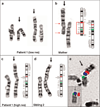Identification of complex chromosome 18 rearrangements by FISH and array CGH in two patients with apparent isochromosome 18q
- PMID: 21567909
- PMCID: PMC3651890
- DOI: 10.1002/ajmg.a.33935
Identification of complex chromosome 18 rearrangements by FISH and array CGH in two patients with apparent isochromosome 18q
Figures



Similar articles
-
A patient with isochromosome 18q, radial-thumb aplasia, thrombocytopenia, and an unbalanced 10;18 chromosome translocation.Am J Med Genet A. 2005 Feb 15;133A(1):93-8. doi: 10.1002/ajmg.a.30535. Am J Med Genet A. 2005. PMID: 15637724 Review.
-
Clinical outcome: a monosomy 18p is better than a tetrasomy 18p.Cytogenet Genome Res. 2014;144(4):294-8. doi: 10.1159/000371461. Epub 2015 Jan 28. Cytogenet Genome Res. 2014. PMID: 25634515
-
Cytogenetic investigation of a child with a mosaic isochromosome 18q and ring 18q.Eur J Med Genet. 2007 Sep-Oct;50(5):379-85. doi: 10.1016/j.ejmg.2007.06.001. Epub 2007 Jul 17. Eur J Med Genet. 2007. PMID: 17716964
-
[Isochromosome long arm 18].Ann Pediatr (Paris). 1977 Sep;24(8-9):611-6. Ann Pediatr (Paris). 1977. PMID: 16211915 French. No abstract available.
-
Isochromosome 18q in a girl with holoprosencephaly, DiGeorge anomaly, and streak ovaries.Am J Med Genet. 1993 Aug 1;47(1):85-8. doi: 10.1002/ajmg.1320470117. Am J Med Genet. 1993. PMID: 8368259 Review.
Cited by
-
Origin, Composition, and Structure of the Supernumerary B Chromosome of Drosophila melanogaster.Genetics. 2018 Dec;210(4):1197-1212. doi: 10.1534/genetics.118.301478. Epub 2018 Sep 24. Genetics. 2018. PMID: 30249684 Free PMC article.
References
-
- Bass HN, Sparkes RS, Miller AA. Features of trisomy 18 and 18p-syndromes in an infant with 45,XY,i(18q) Clin Genet. 1979;16:163–168. - PubMed
-
- Bugge M, Brandt CA, Petersen MB. DNA studies of mono- and pseudodicentric isochromosomes 18q. Am J Med Genet Part A. 2004;127A:230–233. - PubMed
-
- Edwards JH, Harnden DG, Cameron AH, Crosse VM, Wolff OH. A new trisomic syndrome. Lancet. 1960;1:787–790. - PubMed
-
- Froster-Iskenius U, Coerdt W, Rehder H, Schwinger E. Isochromosome 18q with karyotype 46,XX,i(18q). Cytogenetics and pathology. Clin Genet. 1984;26:549–554. - PubMed
Publication types
MeSH terms
Grants and funding
LinkOut - more resources
Full Text Sources
Medical

